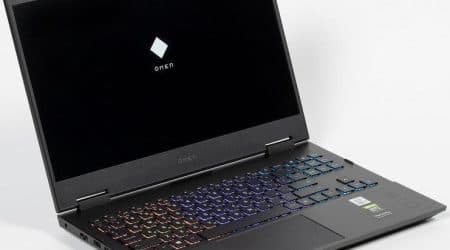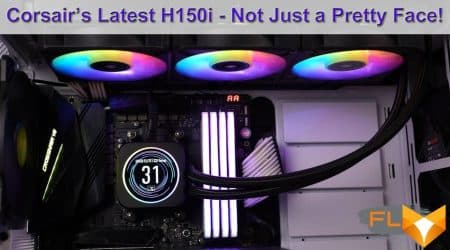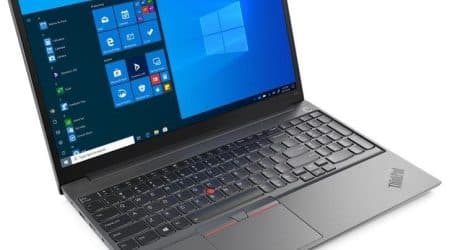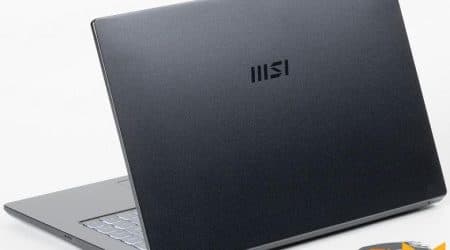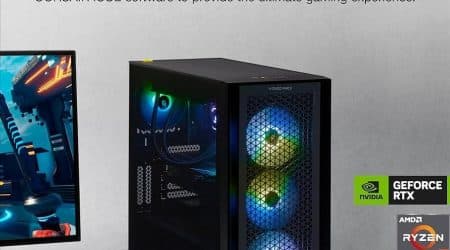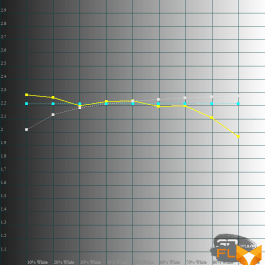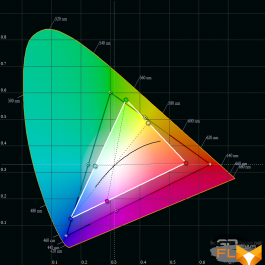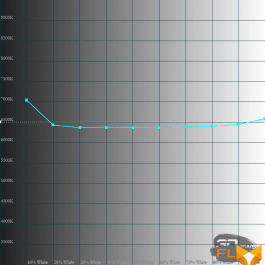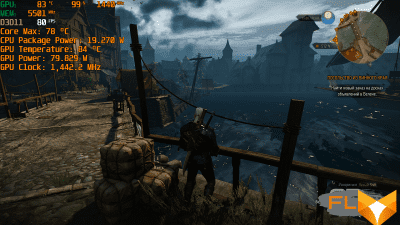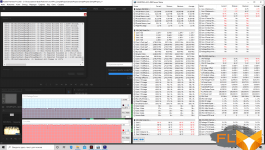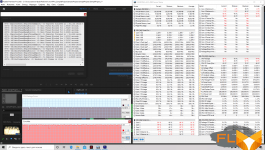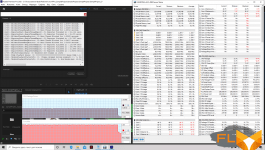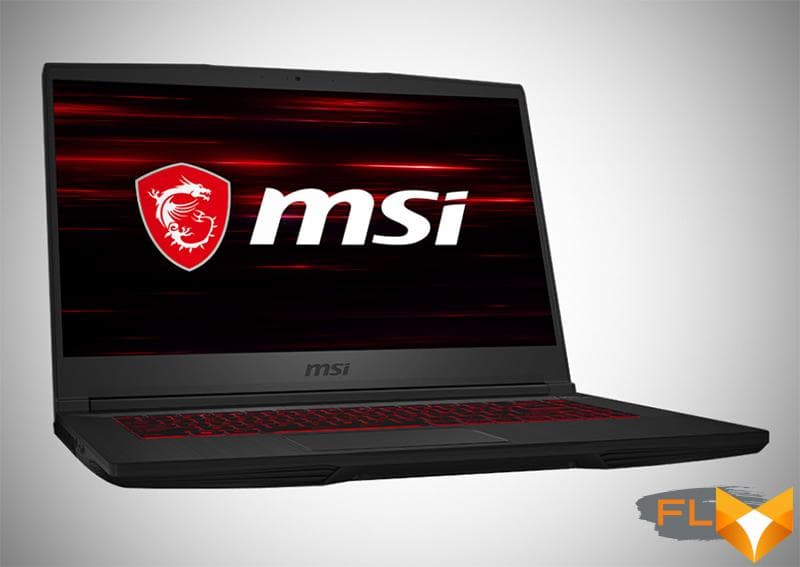


There are still many gaming laptops on the market that are equipped with quad-core Intel processors. At one time, we tested a lot of mobile PC models in which the Core i5-9300H chip was installed. Now gaming laptops are stuffed with 6- and 8-core versions of Core or Ryzen chips. It’s nice to see such progress and competition in the mobile computer market, but is it worth it for a gamer to chase the number of cores? The question is generally rhetorical, because in any gaming system the main component is a video card. Therefore, if the hero of today’s review, the MSI GF65 Thin 9SEXR model, proves worthy in modern games, then there will be nothing to worry about. Here we’ll see.
MSI GF65 Thin 9SEXR
⇡#Specifications, equipment and software
The table below shows the main specifications of the GF65 Thin 9SEXR series of notebooks. Let me remind you that the ninth generation of Core processors (Coffee Lake) is not much different from the modern Comet Lake series, if we compare models with the same number of cores and threads – we have already talked about this in detail. That is why such chips as the Core i5-9300H and Core i7-9750H can still and should be considered modern and relevant.
| MSI GF65 Thin 9SEXR | |
|---|---|
| Primary display | 15.6″ 1920×1080 IPS 15.6″ 1920×1080 IPS 120Hz 15.6″, 1920 × 1080, IPS, 144Hz |
| CPU | Intel Core i7-9750H Intel Core i5-9300H |
| Video card | NVIDIA GeForce RTX 2060 6GB GDDR6 |
| RAM | Up to 64GB DDR4-2666 |
| Install Drives | 1 × M.2 in PCI Express x4 3.0 mode 1 × M.2 in PCI Express x4 3.0 mode and SATA 6Gb/s |
| Optical Drive | None |
| Interfaces | 2 × USB 3.2 Gen1 Type-A 2 x USB 3.2 Gen1 Type-C 1 x 3.5mm mini jack 1 x RJ-45 1 x HDMI |
| Built-in battery | 51 Wh |
| External power supply | 180W |
| Dimensions | 359 × 254 × 22 mm |
| Notebook weight | 1.86kg |
| Operating system | Windows 10 Home Windows 10 Pro |
| Warranty | 2 years |
| Price | $1,200 for 120Hz IPS Model, Core i5-9300H, 256GB SSD, 8GB RAM, and no Windows preinstalled |
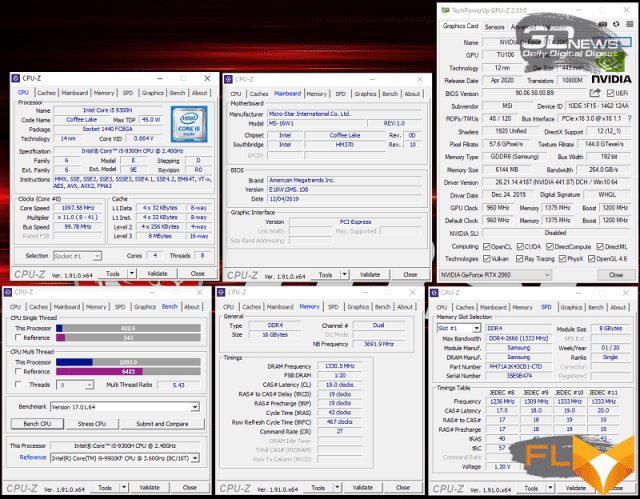
We’ve got a pretty beefed-up version of the GF65 Thin 9SEXR, even though it uses a quad-core Core i5-9300H. The fact is that the laptop immediately has 16 GB of RAM and an SSD with a nominal capacity of 512 GB. I didn’t find such a modification of the MSI laptop on sale, but at the time of this writing, for $ 1200 you could take the DOS version of the MSI GF65 Thin 9SEXR-607XRU – it has only 8 GB of RAM, a 256 GB solid-state drive and a 120-Hz IPS -matrix. And this is one of the most affordable laptops with GeForce RTX 2060.
For wireless connection in MSI GF65 Thin 9SEXR, the Intel Wireless-AC 9560 module is responsible, which supports IEEE 802.11b/g/n/ac standards at 2.4 and 5 GHz and a maximum bandwidth of up to 1.73 Gbps. And this controller supports the Bluetooth 5 standard.
The laptop came with an external Chicony power supply with a power of 180 W and a weight of 500 g. No additional accessories were found in the box.
⇡#Appearance and Input Devices
The design, or rather the GF65 Thin 9SEXR itself, is recognizable – but it cannot be otherwise. The body of the laptop is practical and attractive: the display cover and the keyboard area are made of aluminum, the rest of the laptop case is made of matte plastic. I won’t say that the GF65 panels don’t attract dust and fingerprints – they do. However, metal surfaces are noticeably easier to clean.
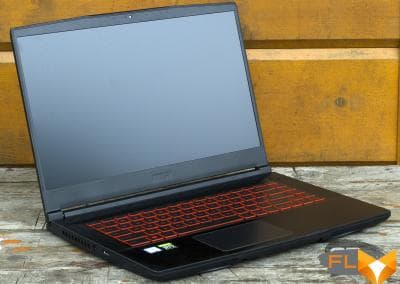 | 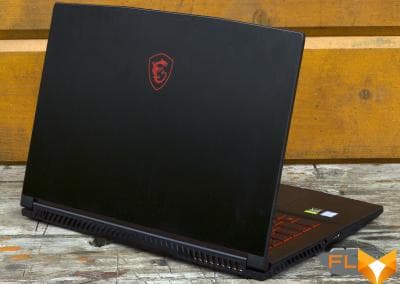 |
The manufacturer, by the way, claims that the use of aluminum made the laptop thinner and lighter. Indeed, the GF65 Thin 9SEXR for gaming “15” weighs a little – less than 1.9 kg, which makes it easy to take it with you to the country, work or study, just putting it in a backpack. The thickness of the laptop is 22 mm – very neat for a PC of this level.
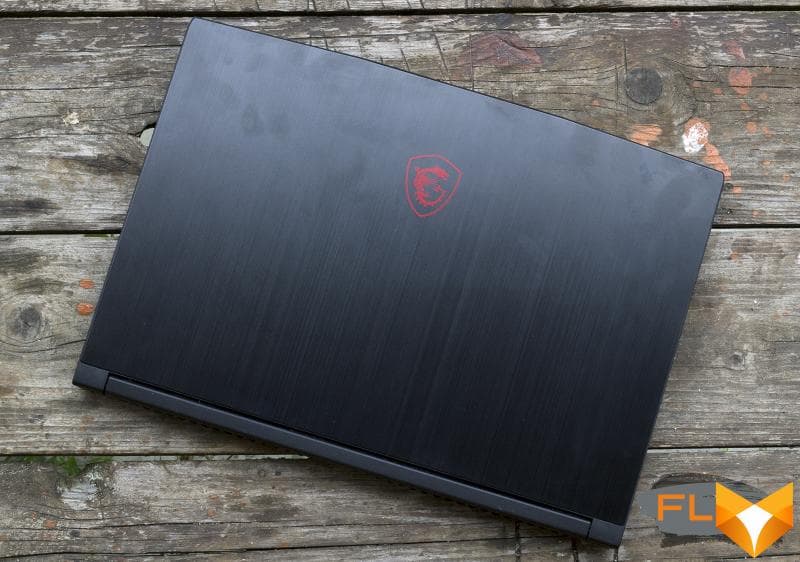
The cover of the “sixty-fifth” is opened by about 140 degrees, and doing it with one hand is as easy as shelling pears. Nevertheless, small loops turned out to be quite tight: the display, when installed in any position, first wobbles slightly, but later on, even the strongest swotting on the keys does not lead to a change in its position.

The main interfaces of the GF65 Thin 9SEXR are located on the sides. On the left, there is only an input for an external power supply connector and an HDMI output. On the right, you’ll find an RJ-45, two USB 3.2 Gen1 Type C and two USB 3.2 Gen1 A types, and a mini-jack for a headset.
There was no place for the card reader, alas.
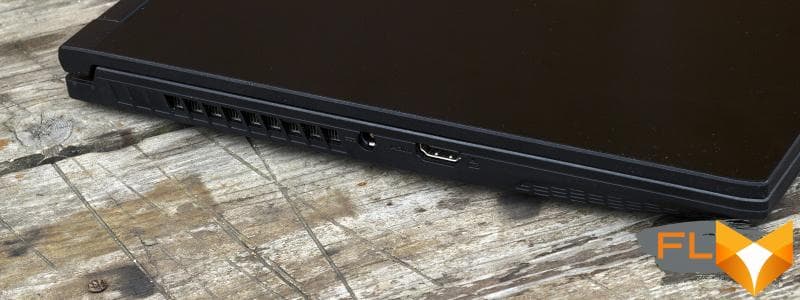
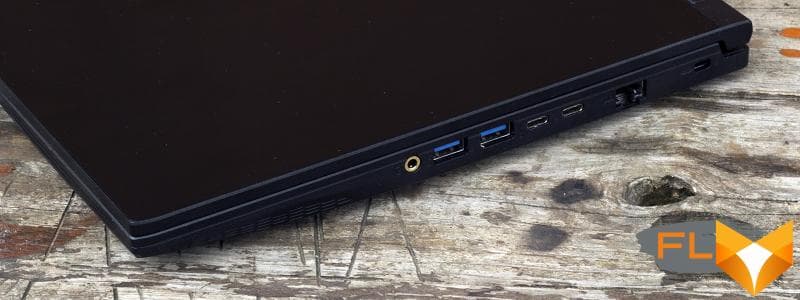
The keyboard layout of the laptop is very similar to the GS66 Stealth, but it does not copy it completely. Here, too, there is no digital block, and this feature can even be called a trend, as there are more and more 15-inch laptops without a digital block.
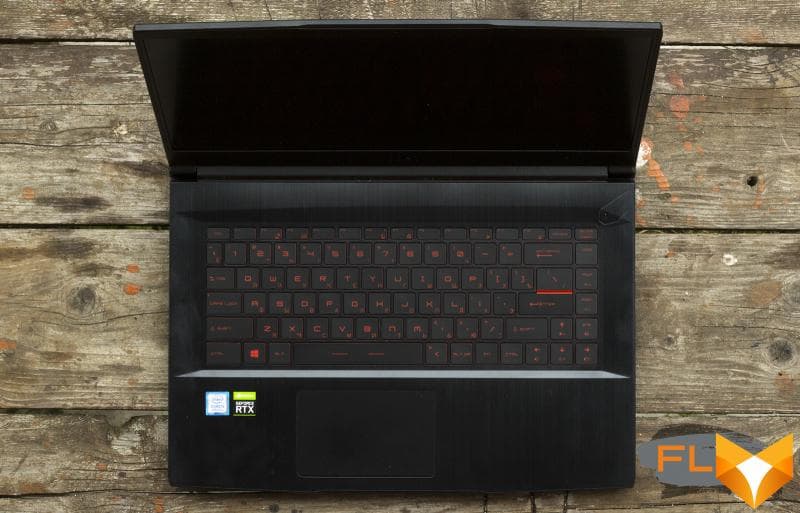
The Home, PgUp, PgDn and End keys are collected in the far right column. This arrangement takes some getting used to, but overall the GF65 Thin 9SEXR’s keyboard is comfortable to use. Additional functions that are activated simultaneously with the Fn key “hang” on the same buttons. The latter, by the way, is located on the right – I think they did it on purpose to activate them with one hand. If this seems unusual, then in the Dragon Center program you can remap the Win and Fn keys. The Shift, Enter, and Left Ctrl keys are just as they should be on a gaming laptop: large and easily identifiable by touch. Pressing is felt quite clearly, I did not reveal any backlash and false positives.
The red backlight goes well with the black buttons. In addition, it has three levels of brightness. As a result, typing on the keyboard is comfortable both day and night.
The touchpad on the GF65 Thin 9SEXR is tempting to be labeled “tiny,” but I’ve actually run into an optical illusion. Visually, the touchpad appears to have a small area, but in reality its width and height are 105 and 66mm, respectively – quite typical dimensions for a touchpad in 15-inch laptops. I have no special complaints about the touch panel. In any case, it will be more convenient to play with a mouse.
Finally, the GF65 Thin 9SEXR has a simple 720p 30Hz webcam. The image quality in a room with artificial light turns out to be frankly bad, so I would not use this camera for streaming.
⇡#Internal design and upgrade options
The laptop is easy to disassemble. The plastic bottom is completely removed without any problems – you just need to unscrew a few screws using a regular Phillips screwdriver.
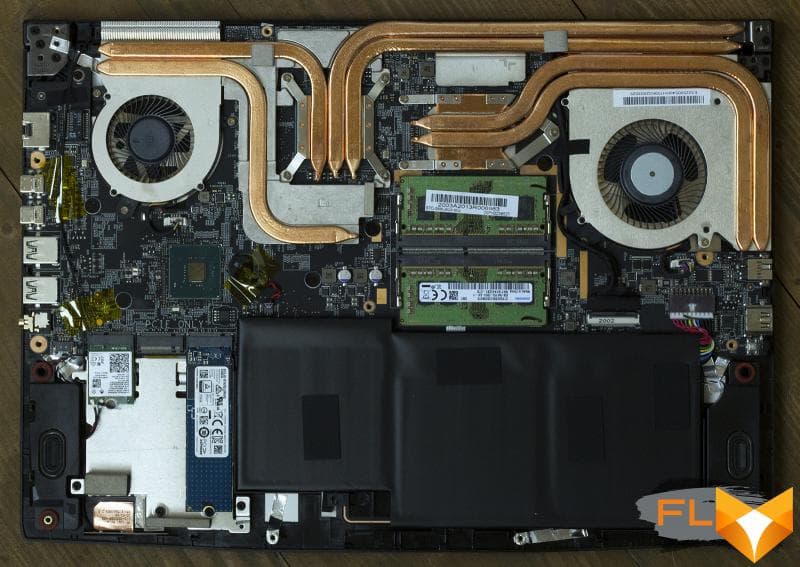
The computer received a separate cooling system. The cooler consists of two tangential fans, a pair of heat sinks and six copper heat pipes. The radiators are small (especially the left one). Four heatpipes cool the GPU and its piping (VRAM and VRM). Two more heatpipes provide heat dissipation from the Core i5-9300H. We will analyze how efficiently the cooler works in the second part of the review.
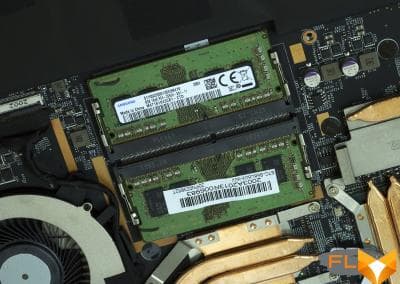 | 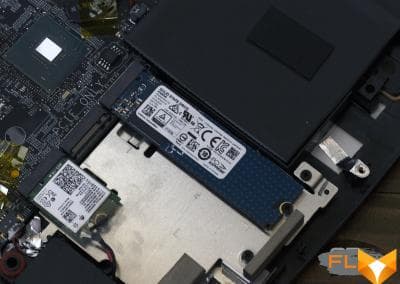 |
We have long been accustomed to the fact that laptops do not have an optical drive – this atavism is found only in frankly cheap devices. It looks like it’s time to consider 2.5-inch drives as a laptop relic, because the GF65 Thin 9SEXR is another mobile PC that exclusively supports M.2 SSD form factor. And most of these laptops have been passing through us lately. However, MSI specifies that in a similar 17-inch model there will still be room for a 2.5-inch drive – in addition to space for one M.2.
Nevertheless, the hero of the review has good opportunities for its further modernization. First, there are two M.2 slots here. If the capacity of the base “solid state” is not enough for you, then you can always buy another SSD – the second port supports storage devices with both PCI Express interface and SATA 6 Gb / s. Secondly, the maximum amount of DDR4-2666 memory is 64 GB. In the case of a test instance, I personally don’t see the point in bothering with a RAM upgrade – 16 GB is now enough for absolutely any game. But for those who buy the previously mentioned version of the GF65 9SEXR-607XRU, I recommend immediately purchasing another 8 GB memory module.
As for the storage devices themselves, a TOSHIBA KBG30ZMV512G SSD and Samsung M471A1K43CB1-CTD RAM were found here.
⇡#Test Methodology
The updated testing methodology for gaming laptops puts even more emphasis on PC gaming. Laptop performance was measured using various software.
Games (Full HD resolution):
- Counter Strike: Global Offensive. DirectX 9. Map Benchmark. Maximum quality, MSAA 8x + FXAA.
- World of Tanks enCore. DirectX 11. Benchmark. Ultra mode, TSSAA HQ.
- Dota 2. DirectX 11. Match recording. Maximum quality.
- The Witcher III: Wild Hunt. DirectX 11. Novigrad and surroundings. Maximum quality.
- GTA V. DirectX 11. Built-in benchmark (last scene). Maximum quality, FXAA + 2x MSAA, advanced quality settings on, 16x AF, image resolution scaling off
- The Elder Scrolls V: Skyrim Special Edition. DirectX 11. Riverwood and surroundings. Maximum quality, TAA. No mods.
- Total War Three Kingdoms. DirectX 11. Built-in benchmark. Max mode, TAA.
- Far Cry New Dawn. DirectX 11. Built-in benchmark. Maximum quality, HD textures – on, TAA.
- Assassin’s Creed Odyssey. DirectX 11. Built-in benchmark. Highest mode.
- Metro: Exodus. DirectX 12. Built-in benchmark. Ultra Mode
- Battlefield V. DirectX 12. The Last Tiger mission. Ultra Mode, TAA, DXR Off
- Shadow of the Tomb Raider. DirectX 12. Built-in benchmark. Maximum quality, DXR – off, TAA.
- Deus Ex: Mankind Divided. DirectX 12. Built-in benchmark. Maximum quality, 2x MSSA.
- Gears 5. DirectX 12. Built-in benchmark. Ultra Mode
- Red Dead Redemption 2. Vulkan. Built-in benchmark (last scene). Maximum quality (advanced settings – off), TAA.
- DOOM Eternal. Vulcan. Beginning of the game. Ultra Mode
Testing the laptop in games was carried out with the activation of the fastest mode suitable for these tasks.
Gaming performance was measured using the well-known MSI Afterburner program. It allows you to get the rendering time of each frame. The use of the 99th percentile instead of the minimum frames per second is due to the desire to clean up the results from random bursts of performance that were provoked by reasons not directly related to the operation of the main components of the platform.
If in a certain game the laptop, using the above graphics quality settings, does not show 60 FPS on average, then we conduct additional tests.
Games (additional testing):
- Metro: Exodus. DirectX 12. Built-in benchmark. High Mode
- Metro: Exodus. DirectX 12. Built-in benchmark. Normal mode.
- Red Dead Redemption 2. Vulkan. Built-in benchmark (last scene). Balanced mode (advanced settings – off), TAA.
- Red Dead Redemption 2. Vulkan. Built-in benchmark (last scene). “Speed” mode (advanced settings – off), TAA.
- Deus Ex: Mankind Divided. DirectX 12. Built-in benchmark. Mode “Very high”, 2x MSSA.
- Deus Ex: Mankind Divided. DirectX 12. Built-in benchmark. Mode “High”, no anti-aliasing.
- Total War Three Kingdoms. DirectX 11. Built-in benchmark. Mode “High”, TAA.
Applications:
- Corona 1.3.Testing rendering speed using the renderer of the same name. Measures the build speed of the standard BTR scene used to measure performance.
- Blender 2.83. Determination of the final rendering speed in one of the popular free packages for creating three-dimensional graphics. The duration of building the final model pavillon_barcelona_v1.2 from Blender Benchmark is measured.
- x265 HD Benchmark. Testing the speed of video transcoding to H.265/HEVC format. The tables and graphs show the average integer value obtained after five runs of the test.
- CINEBENCH R20. Performance measurement of photorealistic 3D rendering in CINEMA 4D animation package, CPU test. The tables and graphs show the average integer value obtained after five runs of the test.
- Adobe Premiere Pro 2020 – Rendering a project in 4K resolution.
- Topaz Video Enhance AI v1.2.3. Performance testing in an AI-based program to improve video detail. The test uses the original video at 1280×720 resolution, which is scaled up by 150% using the Artemis-HQ model: P, HQ, MC.
Comprehensive benchmarks:
- Futuremark PCMARK10 Professional Edition 2.1.2177. Testing in Essentials scenarios (typical work of an average user: launching applications, surfing the Internet, video conferencing), Productivity (office work with a text editor and spreadsheets), Digital Content Creation (creation of digital content: photo editing, non-linear video editing, 3D rendering and visualization -models).
- 3DMark Professional Edition 2.11.6846. Testing in Time Spy and Fire Strike scenes.
- Unigine Superposition Benchmark. 1080p Extreme testing.
Notebook testing in resource-intensive applications was carried out in the default mode without any adjustment of the parameters of the central processor and cooler.
Display testing is performed using the X-Rite i1Display Pro colorimeter and the HCFR application.
The battery life of the laptop was tested in two modes. The first load option – web surfing – involves alternately opening and closing the tabs of the Computeruniverse.ru and Unsplash.com sites with an interval of 30 seconds. For this test, the current version of the Google Chrome browser at the time of testing is used. In the second mode, video in .mkv format and Full HD resolution is played in the built-in player of Windows OS with the repeat function activated. In all cases, the same display brightness was set to 200 cd / m2, and the keyboard backlight (if any) and the sound were turned off. When playing video, the laptop worked in airplane mode.
In games and other applications, the results of the following laptops are considered:
| Test Participants | ||||||
|---|---|---|---|---|---|---|
| Model | Screen | Processor | RAM | Graphics | Drive | Battery |
| ASUS ROG Zephyrus M GU502GU | 15.6”, 1920 × 1080, IPS | Intel Core i7-9750H, 6/12 cores/threads, 2.6 (4.5) GHz, 45W | 16 GB DDR4-2666 Dual Channel | NVIDIA GeForce GTX 1660 Ti 6GB GDDR6 | SSD 512 GB | 76 Wh |
| Acer Nitro 5 AN515-54-56MH | 15.6”, 1920 × 1080, IPS | Intel Core i5-9300H, 6 cores, 2.4 (4.1) GHz, 45W | 8GB DDR4-2666 Dual Channel | NVIDIA GeForce GTX 1660 Ti 6GB GDDR5 | SSD, 1TB | 55 Wh |
| ASUS TUF Gaming A15 FX506IV | 15.6”, 1920 × 1080, IPS | AMD Ryzen 7 4800H 8 cores 16 threads 2.9 (4.2GHz) 45W | 32 GB DDR4-3200 Dual Channel | NVIDIA GeForce RTX 2060 6GB GDDR6 | SSD, 1TB | 90 W⋅h |
| MSI GF65 Thin 9SEXR | 15.6”, 1920 × 1080, IPS | Intel Core i5-9300H, 6 cores, 2.4 (4.1) GHz, 45W | 16 GB DDR4-2666 Dual Channel | NVIDIA GeForce RTX 2060 6GB GDDR6 | SSD 512 GB | 51 Wh |
⇡#Display and sound
According to the official MSI website, the GF65 Thin 9SEXR can be equipped with three different IPS matrices – with a refresh rate of 60, 120 or 144 Hz, but in any case with Full HD resolution. I got a laptop with an AU Optronics B156HAN13.0 screen – this is a 120-Hz IPS-matrix equipped with a matte finish. It has no PWM at any brightness level and has good viewing angles.
The white luminosity, by the way, turned out to be far from a record: the maximum level is 273 cd/m2, and the minimum is 5 cd/m2. Such brightness, however, will be enough if you avoid direct sunlight on the screen.
At the same time, the AU Optronics B156HAN13.0 has a high contrast ratio of 1403: 1, the immersive effect in games and movies will be felt more strongly. The gamma of 2.22 is slightly above the reference value of 2.2, and the color temperature is stable 90% of the time, but often falls slightly below the reference value of 6500 K. The average DeltaE error on the gray scale is 0.97, and the maximum is 2.19.
| Gamma | Gamut | Color temperature |
But with the color gamut of the GF65 Thin 9SEXR display, not everything is good – noticeable deviations in the primary colors are visible. The average error in the ColorChecker 24 test is 3.51 with a maximum deviation of 7.44. And I say again that such matrices as the AU Optronics B156HAN13.0, with such a color reproduction, belong to the average level – perhaps even a little above average. Above average – because there are a lot of laptops on sale with even lower quality IPS displays, and not because “brought for a review“, “the author is blind or does not understand” and that’s it in that spirit. I generally keep quiet about TN TFT installed in cheap laptops. Nevertheless, the AU Optronics B156HAN13.0 is definitely not suitable for those who work with graphic and design applications.
The GF65 Thin 9SEXR has two speakers with a total power of 4 watts, and they “yell” – my respect. The volume reserve of the speakers is really very serious, while at the maximum level I did not notice any extraneous sounds. On the other hand, the sound quality of the laptop itself can be described in just one word – it is flat. The speakers are clearly lacking in bass and mids – a common picture for the vast majority of laptops.
⇡#Efficiency of the cooling system
A visual acquaintance with the laptop cooling system gave hope that the GF65 Thin 9SEXR will not overheat, and the cooler will allow you to squeeze the maximum out of the available hardware. The laptop has several performance modes: Turbo (enabled by default), Sport, Comfort and ECO. The last two should be used when you are not gaming and when the laptop is running on battery power. I did not notice any difference between the Turbo and Sport presets – in both cases, the test model worked at maximum performance. However, you can activate the Cooler Boost function – after turning it on, the CO fans will spin up to the maximum frequency.
Let’s start with the performance of the GF65 Thin 9SEXR in games.
| Summary of laptop operation and setup | |||
|---|---|---|---|
| Laptop mode | Turbo | Turbo + Cooler Boost | |
| Declared GPU Speed (Boost) and Memory Speed | 1200 MHz, 11 Gbps | 1200 MHz, 11 Gbps | |
| Actual GPU clock in The Witcher III | minimal | 1425 MHz | 1470 MHz |
| maximum | 1575 MHz | 1575 MHz | |
| medium | 1442 MHz | 1493 MHz | |
| Maximum noise level | 43 dBA | 50.5 dBA | |
| Average Power | GPU | 79.8W | 79.8W |
| CPU | 19.3W | 19.2W | |
| GPU Temperature | medium | 83 °C | 73 °C |
| maximum | 84 °C | 74 °C | |
| CPU temperature | medium | 78 °C | 69 °C |
| maximum | 93 °C | 93 °C | |
| Performance score | |||
| 3DMark Time Spy test results | 5496 | 5615 | |
| 3DMark Fire Strike test results | 13176 | 13643 | |
| Test results in Unigine Superposition (1080p Extreme) | 3398 | 3492 | |
| Performance gain in benchmarks | +2%, +4%, +3% | ||
| Rated operating mode | Activate Cooler Boost |
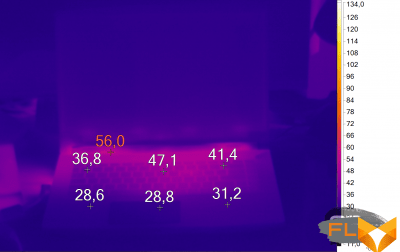 |  |
The real frequency of the graphics chip during a two-hour session in the game The Witcher 3 varied in the range from 1425 to 1575 MHz, and the average was 1442 MHz. The GeForce RTX 2060 chip heats up to 84 degrees Celsius – this is quite an acceptable value for Turing processors, there is no overheating. The average CPU frequency was 3.2 GHz, and its temperature was 78 degrees Celsius on average and 93 degrees Celsius at the peak.
Overall, we can see that the GF65 Thin 9SEXR cooler does its job. Such efficiency of the cooling system comes at a price – noise at the level of 43 dBA. The laptop is well and clearly audible, but the noise is low-frequency, so being near the laptop is quite comfortable. I had no desire to put a headset on my head as soon as possible.
It appeared when I activated the Cooler Boost function, as the noise level of the computer increased to 50.5 dBA. But GPU and CPU temperatures dropped to 74 and 69 degrees Celsius, and the graphics frequency increased by an average of 50 MHz.
I specifically test laptops in The Witcher 3: Wild Hunt, as it heavily loads not only the graphics core, but also the central processor. However, let’s see how the GF65 Thin 9SEXR cooler performs when performing other resource-intensive tasks that primarily load the CPU. To do this, I used the Adobe Premiere Pro 2020 video editor, which can seriously load even the most powerful 8-core AMD and Intel mobile chips.
| Laptop cooling performance in Adobe Premiere Pro 2020 | ||||
|---|---|---|---|---|
| Turbo | Turbo + Cooler Boost | Turbo + Intel XTU | ||
| CPU frequency | Medium | 3.82 GHz | 3.89 GHz | 3.83 GHz |
| CPU temperature | Maximum | 97 °C | 97 °C | 97 °C |
| Medium | 95 °C | 94 °C | 94 °C | |
| Noise level | Maximum | 46.8 dBA | 50.5 dBA | 46.6 dBA |
| CPU power consumption | Average | 50.9W | 54.5W | 49.2W |
| Time to complete task (less is better) | 1337 s | 1316 s | 1349 s | |
| Turbo | Turbo + Cooler Boost | Turbo + XTU |
Let me remind you that the GF65 Thin 9SEXR has a quad-core Core i5-9300H that supports Hyper-Threading technology. When all the cores are loaded, the chip operates at a frequency of 4 GHz, and this is a fairly high figure for a mobile “stone”. In practice, a lot depends on the settings of the laptop, the restrictions set by the manufacturer, the success of one or another instance of the processor and the efficiency of the cooler. In the test sample, judging by the results of the HWiNFO64 program, the 45 W limit for the Core i5-9300H has been removed, which means that its performance is hindered only by the efficiency of the cooler.
In general, MSI engineers love to get the most out of hardware, so there is nothing surprising in the results shown. Yes, the processor under load heats up to 95 degrees Celsius on average, but its power consumption level is constantly above 45 watts. What does it give? The high frequency of all cores of the Core i5-9300H, obviously. The average was 3.8 GHz – the chip works almost at the maximum. For example, the same “stone” installed in the Acer Nitro 5 AN515-54-56MH model operates at an average frequency of only 3.2 GHz in similar conditions. I consider the difference of 600 MHz to be very significant.
⇡#Laptop performance
Modern NVIDIA mobile graphics designed for games can be conditionally divided into three groups: the basic category includes GeForce GTX 1650 and 1650 Ti, the middle category includes GeForce GTX 1660 Ti and GeForce RTX 2060, the highest category includes GeForce RTX 2070 and 2070 SUPER, GeForce RTX 2080 and 2080 SUPER. Also, for almost every GPU, there is its Max-Q version. With the exception of the GeForce GTX 1650 and 1650 Ti, all other NVIDIA models are well suited for today’s Full HD games. However, the GeForce GTX 1660 Ti and GeForce RTX 2060 already face some problems when it comes to the maximum graphics quality settings, because not all applications managed to get the coveted average of 60 frames per second. A better picture is shown in the table below. I had to lower the graphics quality in four games out of 16. Personally, I don’t see a tragedy in this – the transition from maximum quality to high quality in AAA projects, as a rule, does not lead to a dramatic deterioration in the image on the screen. But FPS is growing – this evidence indirectly confirms the fact that the Core i5-9300H and GeForce RTX 2060 are well suited to each other.
| Test results in games, Full HD, FPS | ||
| AVG | 1% MIN | |
| Multiplayer Games | ||
| World of Tanks enCore | 130 | 92 |
| Dota 2 | 89 | 54 |
| Counter Strike: Global Offensive | 242 | 51 |
| Old but still popular games | ||
| The Witcher III: Wild Hunt | 74 | 52 |
| GTA V | 64 | 42 |
| The Elder Scrolls V: Skyrim Special Edition | 107 | 75 |
| Deus Ex: Mankind Divided: Max/Very High/High | 44 | 30 |
| 50 | 34 | |
| 77 | 59 | |
| (Relatively) modern games | ||
| Assassin’s Creed Odyssey: Highest/Very High | 47 | 40 |
| 60 | 43 | |
| Far Cry New Dawn | 75 | 53 |
| Total War Three Kingdoms Max/High | 52 | 34 |
| 67 | 40 | |
| Red Dead Redemption 2 Max Quality/Balanced/Speed | 43 | 33 |
| 45 | 35 | |
| 72 | 53 | |
| Battlefield V | 76 | 50 |
| Metro: Exodus: Ultra/High/Normal | 43 | 23 |
| 52 | 25 | |
| 69 | 34 | |
| Shadow of the Tomb Raider | 70 | 54 |
| Gears 5 | 64 | 47 |
| DOOM Eternal | 132 | 100 |
I would like to draw your attention to the fact that in Time Spy the test model is ahead of the ASUS ROG Zephyrus M by only 2%, although in the Graphics Score subtest, the MSI laptop is ahead by 7%. Yes, Futuremark’s benchmarks turn out to be very processor-dependent, and powerful CPUs used in laptops “drag” graphics chips up.
However, in games, we do not always see such a picture. In many applications, the MSI GF65 Thin 9SEXR is almost as good as the ASUS TUF Gaming A15, which also uses the GeForce RTX 2060 (overclocked, by the way). This means that 4-core Intel processors are still suitable for games – in conjunction with such a GPU, for sure.

We have slightly updated the testing methodology, so the database of laptop results in some applications and benchmarks is only filling up. So, now we are not only testing the processor-memory link, but also exploring the possibilities of graphics processing power.






Below are the results of testing the laptop in the PCMARK10 comprehensive benchmark.
In a number of tests (archiving, working with graphics and photo and video content, interaction with browsers, as well as office applications), the laptop drive plays an important role. The GF65 Thin 9SEXR comes with a 512GB TOSHIBA KBG30ZMV512G model. This is far from the fastest NVMe SSD, but it seems to me that it performs its duties normally.
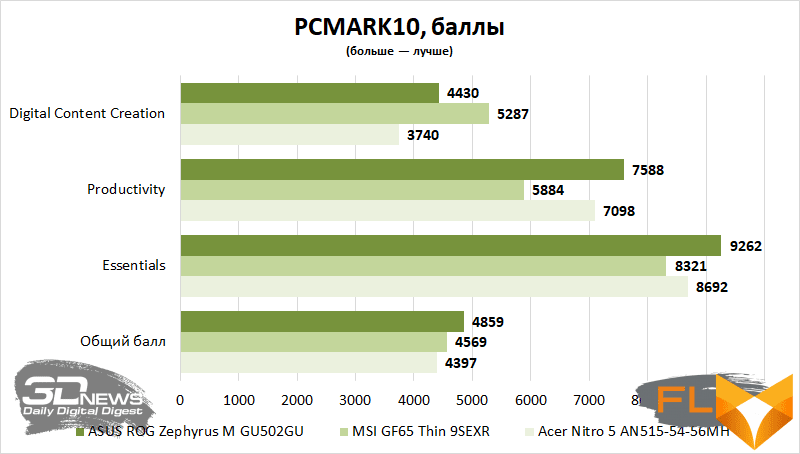
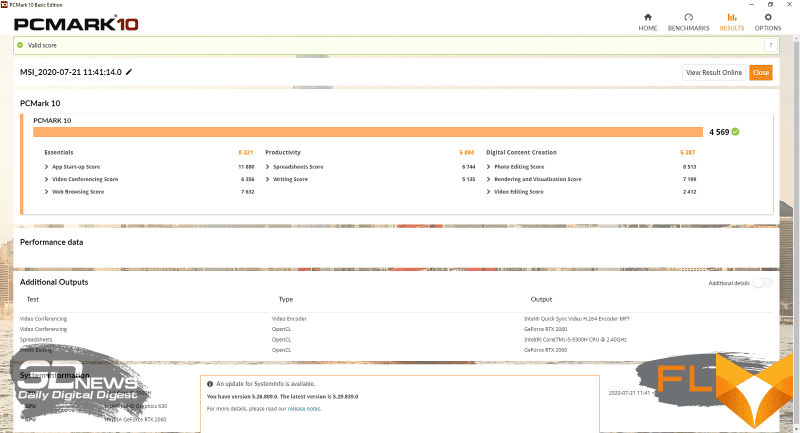

⇡#Laptop offline
The laptop is equipped with a lithium-ion battery of three cells with a total charge of 51 Wh. With a screen brightness of 200 cd/m2, the device lasted less than six hours of video playback, and even less in web surfing mode. The manufacturer claims that the GF65 Thin 9SEXR can work up to 7 hours without recharging. I readily believe in this, since the brightness of the display can be reduced further, moreover, in such tests, a lot depends on the conditions of use of the device. If we were dealing with a compact and lightweight ultrabook, then I would boldly call the demonstrated results (5-6 hours from a single battery charge) a failure. But since we are dealing with a 15-inch gaming laptop, the autonomy of the MSI model is more or less normal.
| Runtime, 200 cd/m2 | |
| Web | 4 hours 24 minutes |
| View video | 5 hours 28 minutes |
⇡#Conclusions
As I said, the MSI GF65 Thin 9SEXR is one of the most affordable laptops with GeForce RTX 2060 graphics. At the time of this writing, the 9SEXR-607XRU model was asking for $1200 – in the current situation, this is a relatively small amount for a laptop with RTX graphics. Plus, I strongly recommend that you immediately buy the system 8 GB of RAM. Well, all those who disagree can safely focus on laptops with the GeForce GTX 1660 Ti.
So, if you keep in mind the information about the price of the GF65 Thin 9SEXR, I have no desire to strongly criticize the device. We can see that the laptop cooler does its job, although it does it quite loudly. We can see that the device uses an average quality display – but this level of image will be enough for playing games and watching videos on the Internet. The laptop saved on SSD – the TOSHIBA model is clearly not one of the best NVMe drives found in laptops. Far from a record, the GF65 Thin 9SEXR turned out to have autonomy.
But otherwise, the GF65 Thin 9SEXR is doing well. Most importantly, the “Core i5-9300H + GeForce RTX 2060” bundle used in this model performs well in modern (and not so) games. Most projects give a comfortable FPS when using the maximum or close to that graphics quality. Yes, there are projects where the GPU is already choking. Yes, there are games that are not enough 6 GB VRAM. Therefore, you will either have to moderate your ardor (read – play with the “High” graphics quality turned on), or save up for a laptop with a GeForce RTX 2070. The choice is small, you understand.
